University E-Business Report: Internet Technologies and Models
VerifiedAdded on 2022/10/09
|13
|2452
|16
Report
AI Summary
This report delves into the multifaceted realm of e-business, exploring its core components and implications. It begins by defining e-business and its role in facilitating online transactions, examining the opportunities and challenges businesses face in the digital landscape. The report then investigates the importance of internet technologies, such as HTML, servers, browsers, and search engines, in driving e-business success. It also explores various online business models, including sales, transaction, affiliate, subscription, and advertising models, analyzing their revenue generation capabilities. Furthermore, the report addresses the impact of electronic commerce on organizations, highlighting its potential to transform processes, expand market reach, and enhance customer interactions. The report concludes by summarizing the key takeaways and emphasizing the significance of e-business in the modern commercial environment.

Running head: THE INTERNET AND E-BUSINESS
The Internet and E-business
Name of the Student:
Name of the University:
Author Note:
The Internet and E-business
Name of the Student:
Name of the University:
Author Note:
Paraphrase This Document
Need a fresh take? Get an instant paraphrase of this document with our AI Paraphraser
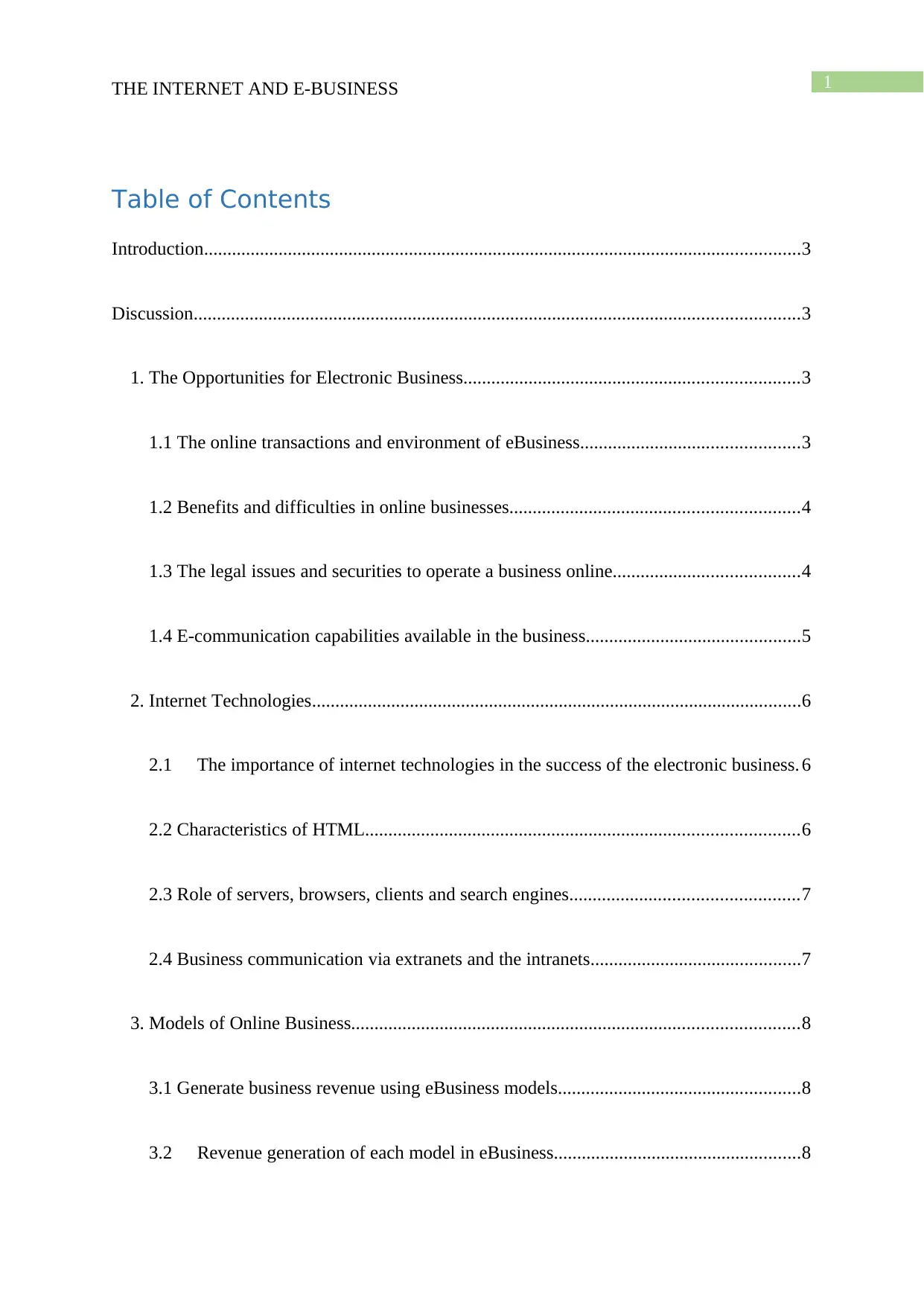
1THE INTERNET AND E-BUSINESS
Table of Contents
Introduction................................................................................................................................3
Discussion..................................................................................................................................3
1. The Opportunities for Electronic Business........................................................................3
1.1 The online transactions and environment of eBusiness...............................................3
1.2 Benefits and difficulties in online businesses..............................................................4
1.3 The legal issues and securities to operate a business online........................................4
1.4 E-communication capabilities available in the business..............................................5
2. Internet Technologies.........................................................................................................6
2.1 The importance of internet technologies in the success of the electronic business. 6
2.2 Characteristics of HTML.............................................................................................6
2.3 Role of servers, browsers, clients and search engines.................................................7
2.4 Business communication via extranets and the intranets.............................................7
3. Models of Online Business................................................................................................8
3.1 Generate business revenue using eBusiness models....................................................8
3.2 Revenue generation of each model in eBusiness.....................................................8
Table of Contents
Introduction................................................................................................................................3
Discussion..................................................................................................................................3
1. The Opportunities for Electronic Business........................................................................3
1.1 The online transactions and environment of eBusiness...............................................3
1.2 Benefits and difficulties in online businesses..............................................................4
1.3 The legal issues and securities to operate a business online........................................4
1.4 E-communication capabilities available in the business..............................................5
2. Internet Technologies.........................................................................................................6
2.1 The importance of internet technologies in the success of the electronic business. 6
2.2 Characteristics of HTML.............................................................................................6
2.3 Role of servers, browsers, clients and search engines.................................................7
2.4 Business communication via extranets and the intranets.............................................7
3. Models of Online Business................................................................................................8
3.1 Generate business revenue using eBusiness models....................................................8
3.2 Revenue generation of each model in eBusiness.....................................................8

2THE INTERNET AND E-BUSINESS
3.3 The impacts of electronic commerce on organization.................................................9
Conclusion................................................................................................................................10
Reference List..........................................................................................................................11
3.3 The impacts of electronic commerce on organization.................................................9
Conclusion................................................................................................................................10
Reference List..........................................................................................................................11
⊘ This is a preview!⊘
Do you want full access?
Subscribe today to unlock all pages.

Trusted by 1+ million students worldwide

3THE INTERNET AND E-BUSINESS
Introduction
E-Business is a type of internet business, also known as "ebusiness" or "eBusiness"
which describes the application of information technologies and communication technologies
which is used to support the business activities with the help of the internet (Chaffey,
Hemphil and Edmundson-Bird 2015). E-business allows companies and organization to
connect with the system efficiently and flexibly for external data processing and internal data
processing, working with more than one suppliers, stakeholders, partners and consumers. E-
commerce means exchange of goods, information and data or services electronically. This
report discusses the opportunities of electronic businesses in an online business transaction.
Second, we will discuss the importance of internet technologies in the success of the electric
business transaction. Finally, several online business models that could be used for a business
to propagate revenue and each model's capacity for revenue generation will also be discussed.
Discussion
1. The Opportunities for Electronic Business
1.1 The online transactions and environment of eBusiness
Electronic business can be defined as the form of online business or commercial trade,
including sharing goods, money, information, and services over the internet. E-commerce
provides the way of exchanging information, money, products and services electronically
between groups, individuals and businesses organizations through the use of the internet. It
focused on the activities of the external relationship between vendors, customers,
stakeholders, companies and business organizations (Laudon and Traver 2013). Today, e-
Introduction
E-Business is a type of internet business, also known as "ebusiness" or "eBusiness"
which describes the application of information technologies and communication technologies
which is used to support the business activities with the help of the internet (Chaffey,
Hemphil and Edmundson-Bird 2015). E-business allows companies and organization to
connect with the system efficiently and flexibly for external data processing and internal data
processing, working with more than one suppliers, stakeholders, partners and consumers. E-
commerce means exchange of goods, information and data or services electronically. This
report discusses the opportunities of electronic businesses in an online business transaction.
Second, we will discuss the importance of internet technologies in the success of the electric
business transaction. Finally, several online business models that could be used for a business
to propagate revenue and each model's capacity for revenue generation will also be discussed.
Discussion
1. The Opportunities for Electronic Business
1.1 The online transactions and environment of eBusiness
Electronic business can be defined as the form of online business or commercial trade,
including sharing goods, money, information, and services over the internet. E-commerce
provides the way of exchanging information, money, products and services electronically
between groups, individuals and businesses organizations through the use of the internet. It
focused on the activities of the external relationship between vendors, customers,
stakeholders, companies and business organizations (Laudon and Traver 2013). Today, e-
Paraphrase This Document
Need a fresh take? Get an instant paraphrase of this document with our AI Paraphraser
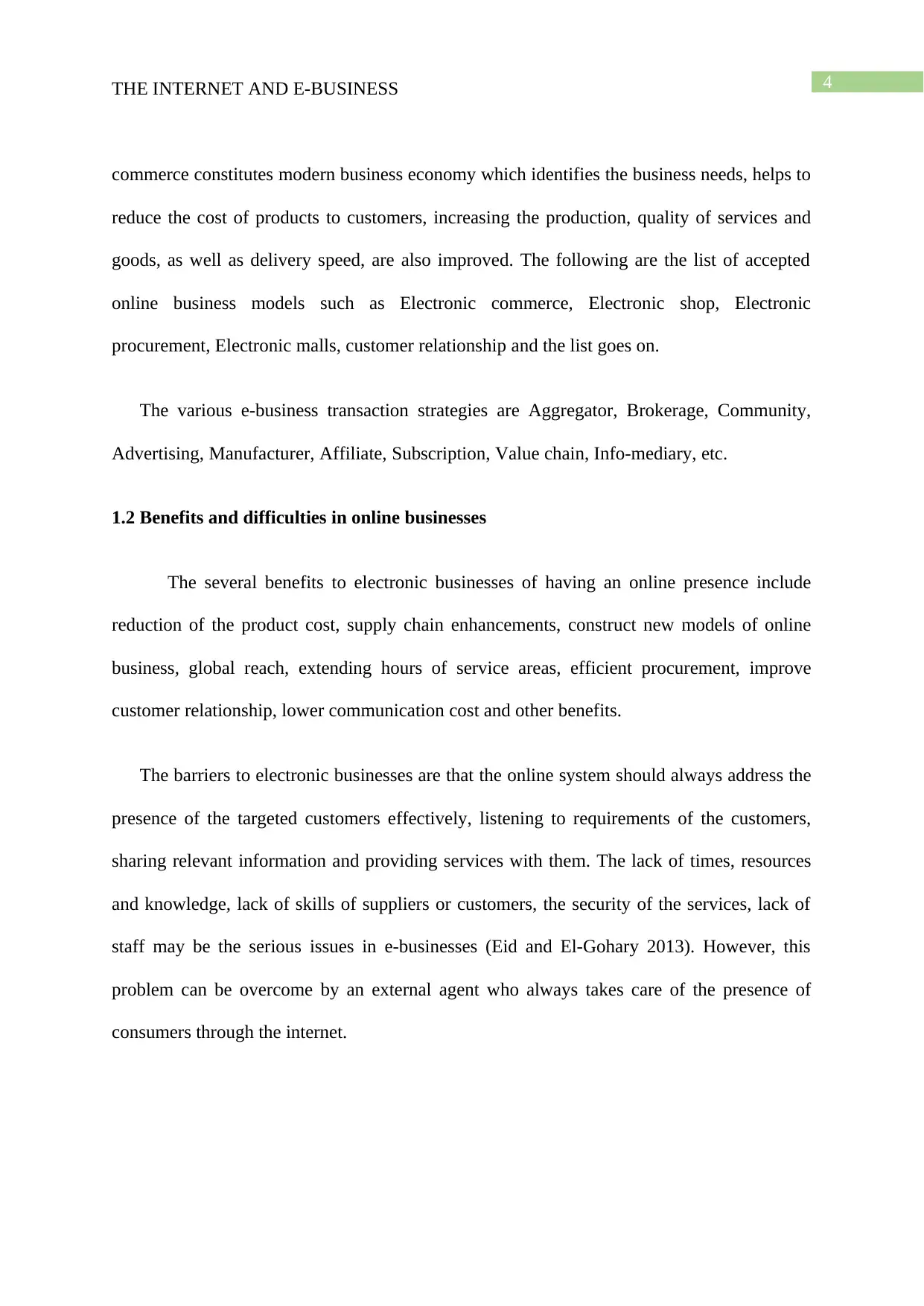
4THE INTERNET AND E-BUSINESS
commerce constitutes modern business economy which identifies the business needs, helps to
reduce the cost of products to customers, increasing the production, quality of services and
goods, as well as delivery speed, are also improved. The following are the list of accepted
online business models such as Electronic commerce, Electronic shop, Electronic
procurement, Electronic malls, customer relationship and the list goes on.
The various e-business transaction strategies are Aggregator, Brokerage, Community,
Advertising, Manufacturer, Affiliate, Subscription, Value chain, Info-mediary, etc.
1.2 Benefits and difficulties in online businesses
The several benefits to electronic businesses of having an online presence include
reduction of the product cost, supply chain enhancements, construct new models of online
business, global reach, extending hours of service areas, efficient procurement, improve
customer relationship, lower communication cost and other benefits.
The barriers to electronic businesses are that the online system should always address the
presence of the targeted customers effectively, listening to requirements of the customers,
sharing relevant information and providing services with them. The lack of times, resources
and knowledge, lack of skills of suppliers or customers, the security of the services, lack of
staff may be the serious issues in e-businesses (Eid and El-Gohary 2013). However, this
problem can be overcome by an external agent who always takes care of the presence of
consumers through the internet.
commerce constitutes modern business economy which identifies the business needs, helps to
reduce the cost of products to customers, increasing the production, quality of services and
goods, as well as delivery speed, are also improved. The following are the list of accepted
online business models such as Electronic commerce, Electronic shop, Electronic
procurement, Electronic malls, customer relationship and the list goes on.
The various e-business transaction strategies are Aggregator, Brokerage, Community,
Advertising, Manufacturer, Affiliate, Subscription, Value chain, Info-mediary, etc.
1.2 Benefits and difficulties in online businesses
The several benefits to electronic businesses of having an online presence include
reduction of the product cost, supply chain enhancements, construct new models of online
business, global reach, extending hours of service areas, efficient procurement, improve
customer relationship, lower communication cost and other benefits.
The barriers to electronic businesses are that the online system should always address the
presence of the targeted customers effectively, listening to requirements of the customers,
sharing relevant information and providing services with them. The lack of times, resources
and knowledge, lack of skills of suppliers or customers, the security of the services, lack of
staff may be the serious issues in e-businesses (Eid and El-Gohary 2013). However, this
problem can be overcome by an external agent who always takes care of the presence of
consumers through the internet.
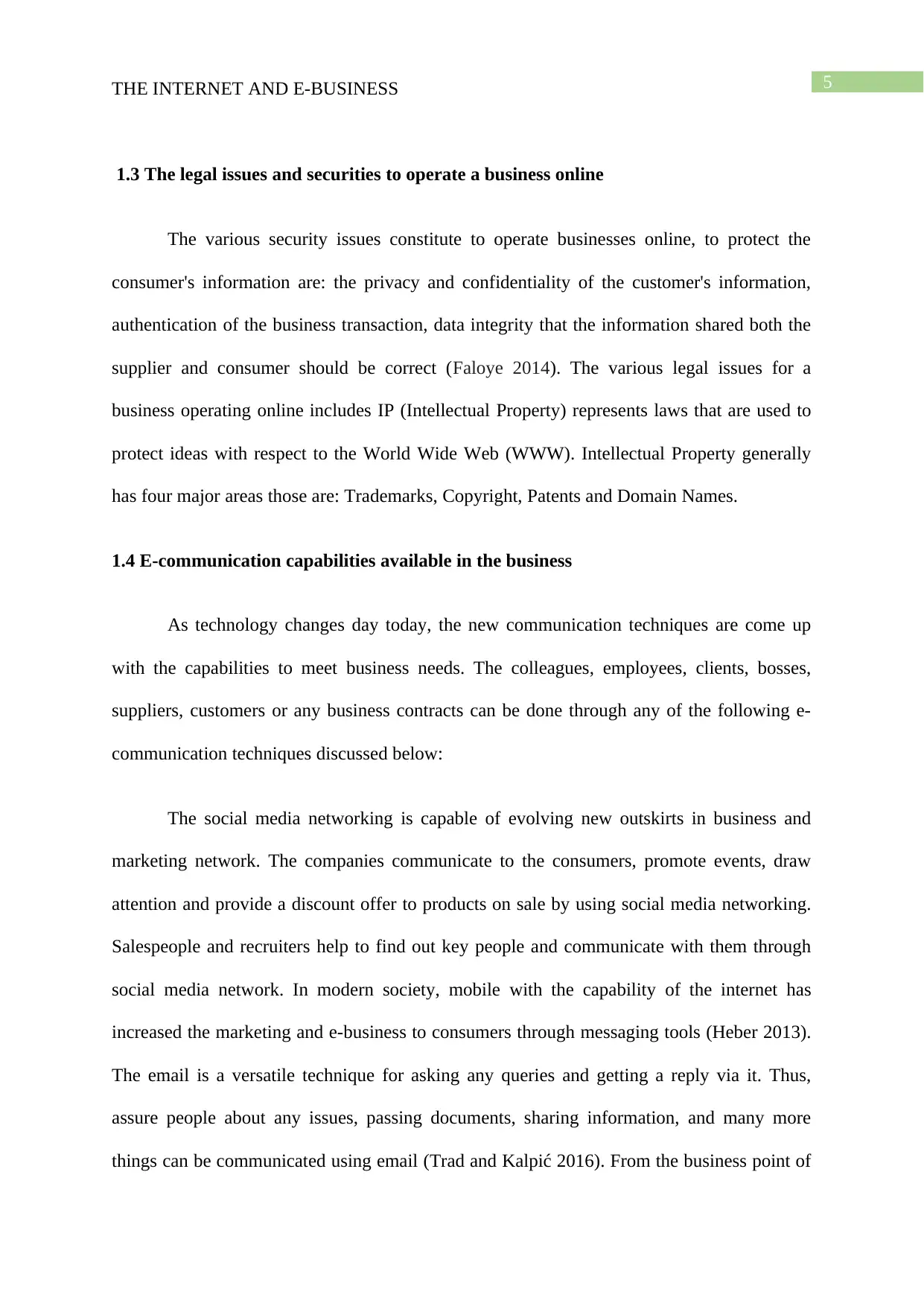
5THE INTERNET AND E-BUSINESS
1.3 The legal issues and securities to operate a business online
The various security issues constitute to operate businesses online, to protect the
consumer's information are: the privacy and confidentiality of the customer's information,
authentication of the business transaction, data integrity that the information shared both the
supplier and consumer should be correct (Faloye 2014). The various legal issues for a
business operating online includes IP (Intellectual Property) represents laws that are used to
protect ideas with respect to the World Wide Web (WWW). Intellectual Property generally
has four major areas those are: Trademarks, Copyright, Patents and Domain Names.
1.4 E-communication capabilities available in the business
As technology changes day today, the new communication techniques are come up
with the capabilities to meet business needs. The colleagues, employees, clients, bosses,
suppliers, customers or any business contracts can be done through any of the following e-
communication techniques discussed below:
The social media networking is capable of evolving new outskirts in business and
marketing network. The companies communicate to the consumers, promote events, draw
attention and provide a discount offer to products on sale by using social media networking.
Salespeople and recruiters help to find out key people and communicate with them through
social media network. In modern society, mobile with the capability of the internet has
increased the marketing and e-business to consumers through messaging tools (Heber 2013).
The email is a versatile technique for asking any queries and getting a reply via it. Thus,
assure people about any issues, passing documents, sharing information, and many more
things can be communicated using email (Trad and Kalpić 2016). From the business point of
1.3 The legal issues and securities to operate a business online
The various security issues constitute to operate businesses online, to protect the
consumer's information are: the privacy and confidentiality of the customer's information,
authentication of the business transaction, data integrity that the information shared both the
supplier and consumer should be correct (Faloye 2014). The various legal issues for a
business operating online includes IP (Intellectual Property) represents laws that are used to
protect ideas with respect to the World Wide Web (WWW). Intellectual Property generally
has four major areas those are: Trademarks, Copyright, Patents and Domain Names.
1.4 E-communication capabilities available in the business
As technology changes day today, the new communication techniques are come up
with the capabilities to meet business needs. The colleagues, employees, clients, bosses,
suppliers, customers or any business contracts can be done through any of the following e-
communication techniques discussed below:
The social media networking is capable of evolving new outskirts in business and
marketing network. The companies communicate to the consumers, promote events, draw
attention and provide a discount offer to products on sale by using social media networking.
Salespeople and recruiters help to find out key people and communicate with them through
social media network. In modern society, mobile with the capability of the internet has
increased the marketing and e-business to consumers through messaging tools (Heber 2013).
The email is a versatile technique for asking any queries and getting a reply via it. Thus,
assure people about any issues, passing documents, sharing information, and many more
things can be communicated using email (Trad and Kalpić 2016). From the business point of
⊘ This is a preview!⊘
Do you want full access?
Subscribe today to unlock all pages.

Trusted by 1+ million students worldwide
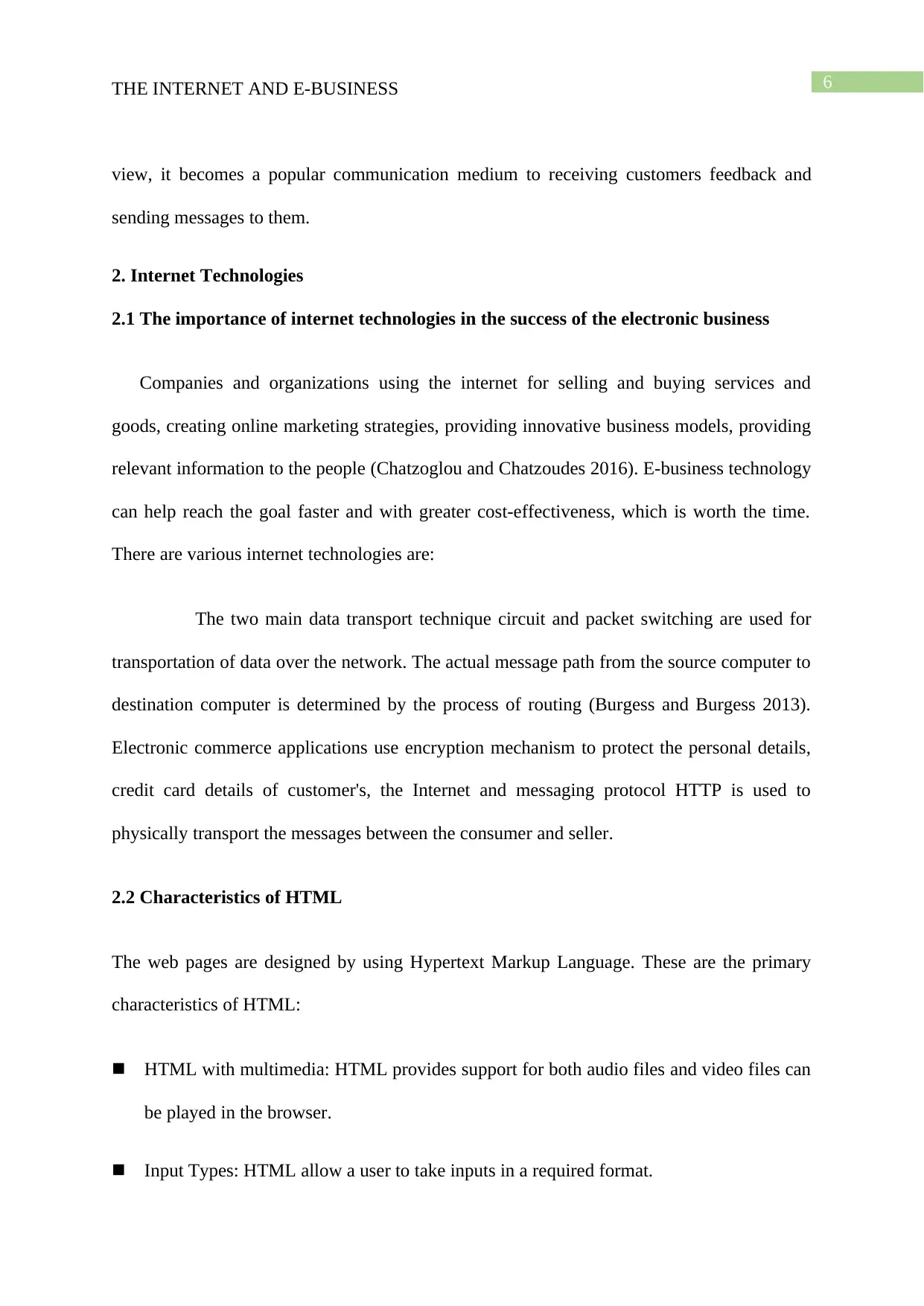
6THE INTERNET AND E-BUSINESS
view, it becomes a popular communication medium to receiving customers feedback and
sending messages to them.
2. Internet Technologies
2.1 The importance of internet technologies in the success of the electronic business
Companies and organizations using the internet for selling and buying services and
goods, creating online marketing strategies, providing innovative business models, providing
relevant information to the people (Chatzoglou and Chatzoudes 2016). E-business technology
can help reach the goal faster and with greater cost-effectiveness, which is worth the time.
There are various internet technologies are:
The two main data transport technique circuit and packet switching are used for
transportation of data over the network. The actual message path from the source computer to
destination computer is determined by the process of routing (Burgess and Burgess 2013).
Electronic commerce applications use encryption mechanism to protect the personal details,
credit card details of customer's, the Internet and messaging protocol HTTP is used to
physically transport the messages between the consumer and seller.
2.2 Characteristics of HTML
The web pages are designed by using Hypertext Markup Language. These are the primary
characteristics of HTML:
HTML with multimedia: HTML provides support for both audio files and video files can
be played in the browser.
Input Types: HTML allow a user to take inputs in a required format.
view, it becomes a popular communication medium to receiving customers feedback and
sending messages to them.
2. Internet Technologies
2.1 The importance of internet technologies in the success of the electronic business
Companies and organizations using the internet for selling and buying services and
goods, creating online marketing strategies, providing innovative business models, providing
relevant information to the people (Chatzoglou and Chatzoudes 2016). E-business technology
can help reach the goal faster and with greater cost-effectiveness, which is worth the time.
There are various internet technologies are:
The two main data transport technique circuit and packet switching are used for
transportation of data over the network. The actual message path from the source computer to
destination computer is determined by the process of routing (Burgess and Burgess 2013).
Electronic commerce applications use encryption mechanism to protect the personal details,
credit card details of customer's, the Internet and messaging protocol HTTP is used to
physically transport the messages between the consumer and seller.
2.2 Characteristics of HTML
The web pages are designed by using Hypertext Markup Language. These are the primary
characteristics of HTML:
HTML with multimedia: HTML provides support for both audio files and video files can
be played in the browser.
Input Types: HTML allow a user to take inputs in a required format.
Paraphrase This Document
Need a fresh take? Get an instant paraphrase of this document with our AI Paraphraser
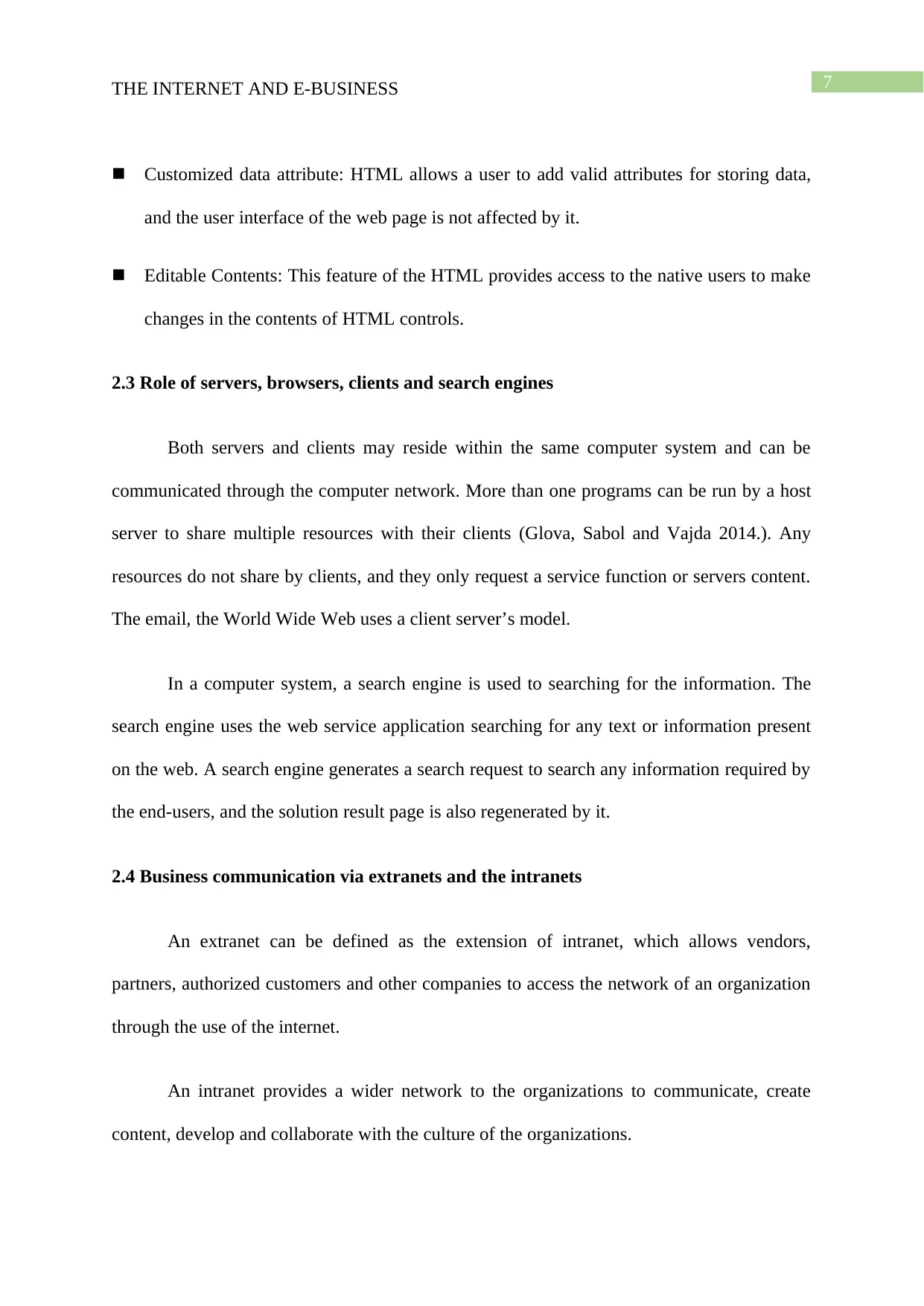
7THE INTERNET AND E-BUSINESS
Customized data attribute: HTML allows a user to add valid attributes for storing data,
and the user interface of the web page is not affected by it.
Editable Contents: This feature of the HTML provides access to the native users to make
changes in the contents of HTML controls.
2.3 Role of servers, browsers, clients and search engines
Both servers and clients may reside within the same computer system and can be
communicated through the computer network. More than one programs can be run by a host
server to share multiple resources with their clients (Glova, Sabol and Vajda 2014.). Any
resources do not share by clients, and they only request a service function or servers content.
The email, the World Wide Web uses a client server’s model.
In a computer system, a search engine is used to searching for the information. The
search engine uses the web service application searching for any text or information present
on the web. A search engine generates a search request to search any information required by
the end-users, and the solution result page is also regenerated by it.
2.4 Business communication via extranets and the intranets
An extranet can be defined as the extension of intranet, which allows vendors,
partners, authorized customers and other companies to access the network of an organization
through the use of the internet.
An intranet provides a wider network to the organizations to communicate, create
content, develop and collaborate with the culture of the organizations.
Customized data attribute: HTML allows a user to add valid attributes for storing data,
and the user interface of the web page is not affected by it.
Editable Contents: This feature of the HTML provides access to the native users to make
changes in the contents of HTML controls.
2.3 Role of servers, browsers, clients and search engines
Both servers and clients may reside within the same computer system and can be
communicated through the computer network. More than one programs can be run by a host
server to share multiple resources with their clients (Glova, Sabol and Vajda 2014.). Any
resources do not share by clients, and they only request a service function or servers content.
The email, the World Wide Web uses a client server’s model.
In a computer system, a search engine is used to searching for the information. The
search engine uses the web service application searching for any text or information present
on the web. A search engine generates a search request to search any information required by
the end-users, and the solution result page is also regenerated by it.
2.4 Business communication via extranets and the intranets
An extranet can be defined as the extension of intranet, which allows vendors,
partners, authorized customers and other companies to access the network of an organization
through the use of the internet.
An intranet provides a wider network to the organizations to communicate, create
content, develop and collaborate with the culture of the organizations.
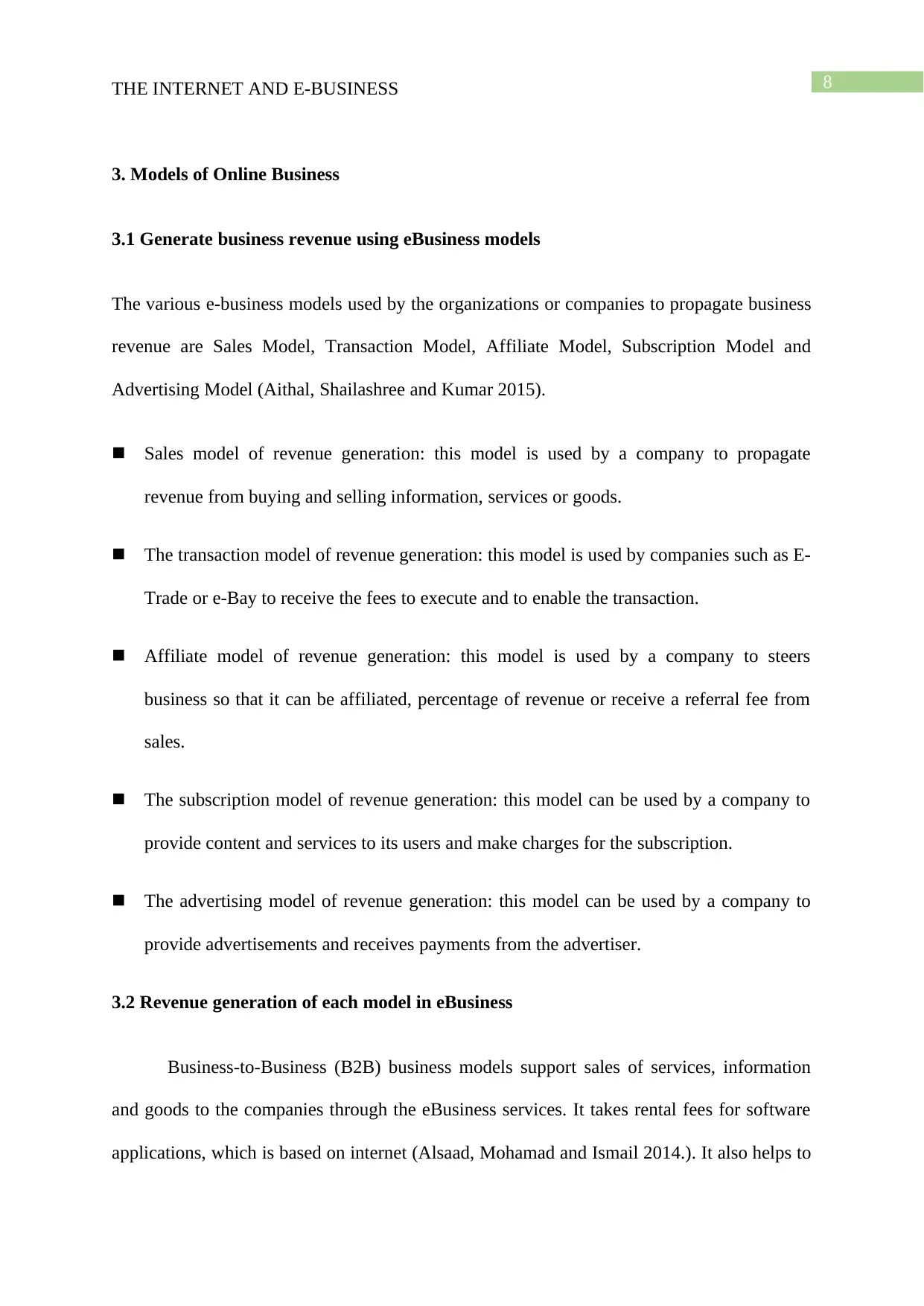
8THE INTERNET AND E-BUSINESS
3. Models of Online Business
3.1 Generate business revenue using eBusiness models
The various e-business models used by the organizations or companies to propagate business
revenue are Sales Model, Transaction Model, Affiliate Model, Subscription Model and
Advertising Model (Aithal, Shailashree and Kumar 2015).
Sales model of revenue generation: this model is used by a company to propagate
revenue from buying and selling information, services or goods.
The transaction model of revenue generation: this model is used by companies such as E-
Trade or e-Bay to receive the fees to execute and to enable the transaction.
Affiliate model of revenue generation: this model is used by a company to steers
business so that it can be affiliated, percentage of revenue or receive a referral fee from
sales.
The subscription model of revenue generation: this model can be used by a company to
provide content and services to its users and make charges for the subscription.
The advertising model of revenue generation: this model can be used by a company to
provide advertisements and receives payments from the advertiser.
3.2 Revenue generation of each model in eBusiness
Business-to-Business (B2B) business models support sales of services, information
and goods to the companies through the eBusiness services. It takes rental fees for software
applications, which is based on internet (Alsaad, Mohamad and Ismail 2014.). It also helps to
3. Models of Online Business
3.1 Generate business revenue using eBusiness models
The various e-business models used by the organizations or companies to propagate business
revenue are Sales Model, Transaction Model, Affiliate Model, Subscription Model and
Advertising Model (Aithal, Shailashree and Kumar 2015).
Sales model of revenue generation: this model is used by a company to propagate
revenue from buying and selling information, services or goods.
The transaction model of revenue generation: this model is used by companies such as E-
Trade or e-Bay to receive the fees to execute and to enable the transaction.
Affiliate model of revenue generation: this model is used by a company to steers
business so that it can be affiliated, percentage of revenue or receive a referral fee from
sales.
The subscription model of revenue generation: this model can be used by a company to
provide content and services to its users and make charges for the subscription.
The advertising model of revenue generation: this model can be used by a company to
provide advertisements and receives payments from the advertiser.
3.2 Revenue generation of each model in eBusiness
Business-to-Business (B2B) business models support sales of services, information
and goods to the companies through the eBusiness services. It takes rental fees for software
applications, which is based on internet (Alsaad, Mohamad and Ismail 2014.). It also helps to
⊘ This is a preview!⊘
Do you want full access?
Subscribe today to unlock all pages.

Trusted by 1+ million students worldwide

9THE INTERNET AND E-BUSINESS
bring consumers and suppliers for a particular organization to reduced procurement costs. For
examples, e-Steel.com, TradeOut.com.
Business-to-Consumer (B2C) business models support internet based business
application to create e-business market that brings consumers and suppliers together. It
allows online sells transactions such as travel agents and stockbroker, thus increase the
customer's productivity so that the things can be done more cheaply and faster way (Cherif
and Grant 2014). For example, E-Trade.com, e-Bay.com.
3.3 The impacts of electronic commerce on organization
E-commerce has the potential impact on organizations in future. It will help processes
sell directly to customers. The small as well as medium sized enterprises, also get a wider
market to meet up their facilities. In fact, it offers customers a varied range of opportunities to
direct banking, shopping and other e-business transactions using communication devices or
home computers, therefore, increasing the production in the organization.
bring consumers and suppliers for a particular organization to reduced procurement costs. For
examples, e-Steel.com, TradeOut.com.
Business-to-Consumer (B2C) business models support internet based business
application to create e-business market that brings consumers and suppliers together. It
allows online sells transactions such as travel agents and stockbroker, thus increase the
customer's productivity so that the things can be done more cheaply and faster way (Cherif
and Grant 2014). For example, E-Trade.com, e-Bay.com.
3.3 The impacts of electronic commerce on organization
E-commerce has the potential impact on organizations in future. It will help processes
sell directly to customers. The small as well as medium sized enterprises, also get a wider
market to meet up their facilities. In fact, it offers customers a varied range of opportunities to
direct banking, shopping and other e-business transactions using communication devices or
home computers, therefore, increasing the production in the organization.
Paraphrase This Document
Need a fresh take? Get an instant paraphrase of this document with our AI Paraphraser
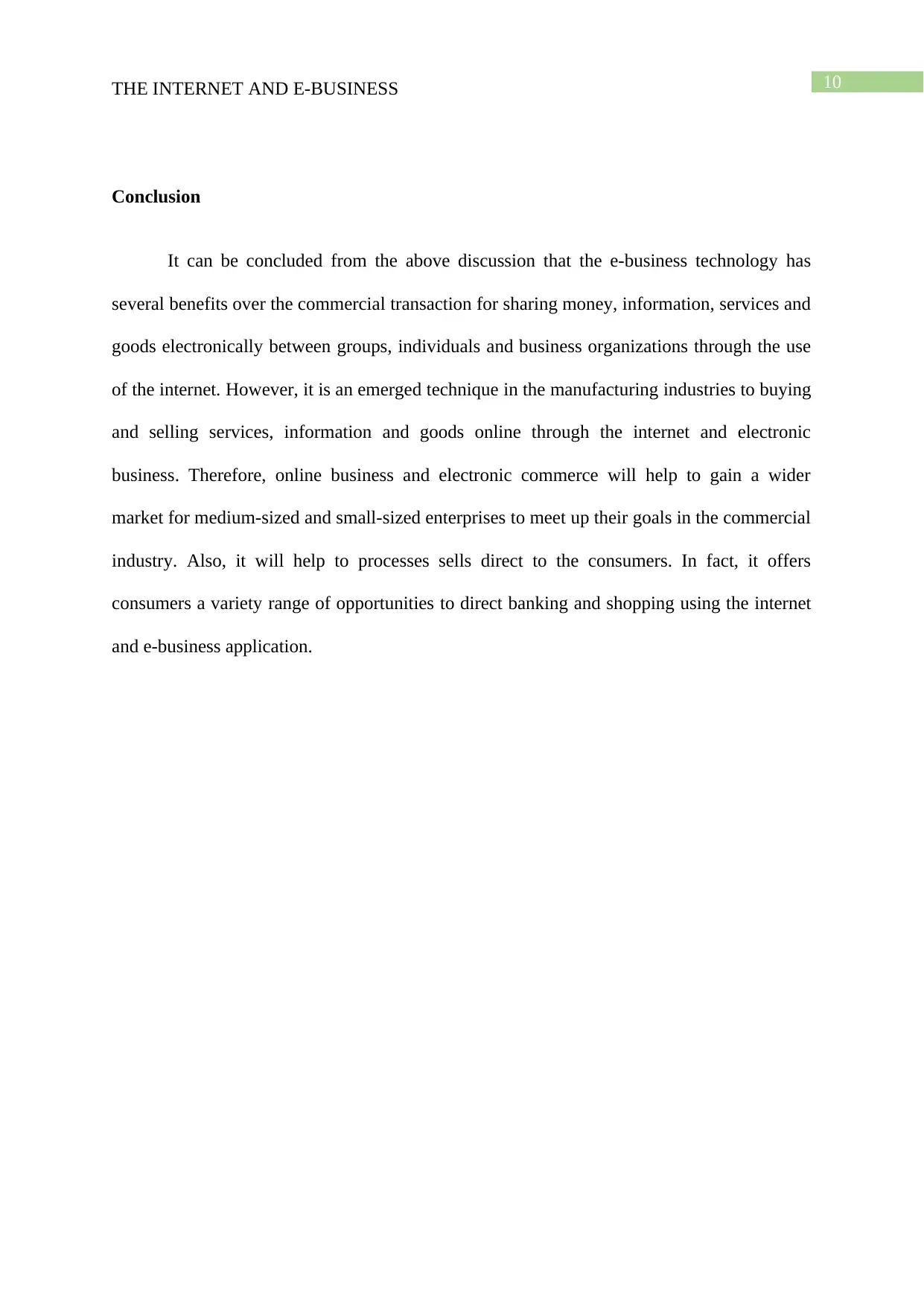
10THE INTERNET AND E-BUSINESS
Conclusion
It can be concluded from the above discussion that the e-business technology has
several benefits over the commercial transaction for sharing money, information, services and
goods electronically between groups, individuals and business organizations through the use
of the internet. However, it is an emerged technique in the manufacturing industries to buying
and selling services, information and goods online through the internet and electronic
business. Therefore, online business and electronic commerce will help to gain a wider
market for medium-sized and small-sized enterprises to meet up their goals in the commercial
industry. Also, it will help to processes sells direct to the consumers. In fact, it offers
consumers a variety range of opportunities to direct banking and shopping using the internet
and e-business application.
Conclusion
It can be concluded from the above discussion that the e-business technology has
several benefits over the commercial transaction for sharing money, information, services and
goods electronically between groups, individuals and business organizations through the use
of the internet. However, it is an emerged technique in the manufacturing industries to buying
and selling services, information and goods online through the internet and electronic
business. Therefore, online business and electronic commerce will help to gain a wider
market for medium-sized and small-sized enterprises to meet up their goals in the commercial
industry. Also, it will help to processes sells direct to the consumers. In fact, it offers
consumers a variety range of opportunities to direct banking and shopping using the internet
and e-business application.

11THE INTERNET AND E-BUSINESS
Reference List
Aithal, P.S., Shailashree, V. and Kumar, P.M., 2015. A new ABCD technique to analyze
business models & concepts. International Journal of Management, IT and Engineering,
5(4), pp.409-423.
Alsaad, A.K., Mohamad, R. and Ismail, N.A., 2014. The moderating role of power exercise
in B2B e-commerce adoption decision. Procedia-Social and Behavioral Sciences, 130,
pp.515-523.
Burgess, C. and Burgess, M. (2013). The Social Employee: How Great Companies Make
Social Media Work. New York, McGraw Hill.
Chaffey, D., Hemphill, T. and Edmundson-Bird, D., 2015. Digital business and e-commerce
management. Pearson UK.
Chatzoglou, P. and Chatzoudes, D., 2016. Factors affecting e-business adoption in SMEs: an
empirical research. Journal of Enterprise Information Management, 29(3), pp.327-358.
Cherif, E. and Grant, D., 2014. Analysis of e-business models in real estate. Electronic
Commerce Research, 14(1), pp.25-50.
Eid, R. and El-Gohary, H., 2013. The impact of E-marketing use on small business
enterprises' marketing success. The Service Industries Journal, 33(1), pp.31-50.
Faloye, D.O., 2014. The adoption of e-commerce in small businesses: an empirical evidence
from retail sector in Nigeria. Journal of Business and Retail Management Research, 8(2).
Reference List
Aithal, P.S., Shailashree, V. and Kumar, P.M., 2015. A new ABCD technique to analyze
business models & concepts. International Journal of Management, IT and Engineering,
5(4), pp.409-423.
Alsaad, A.K., Mohamad, R. and Ismail, N.A., 2014. The moderating role of power exercise
in B2B e-commerce adoption decision. Procedia-Social and Behavioral Sciences, 130,
pp.515-523.
Burgess, C. and Burgess, M. (2013). The Social Employee: How Great Companies Make
Social Media Work. New York, McGraw Hill.
Chaffey, D., Hemphill, T. and Edmundson-Bird, D., 2015. Digital business and e-commerce
management. Pearson UK.
Chatzoglou, P. and Chatzoudes, D., 2016. Factors affecting e-business adoption in SMEs: an
empirical research. Journal of Enterprise Information Management, 29(3), pp.327-358.
Cherif, E. and Grant, D., 2014. Analysis of e-business models in real estate. Electronic
Commerce Research, 14(1), pp.25-50.
Eid, R. and El-Gohary, H., 2013. The impact of E-marketing use on small business
enterprises' marketing success. The Service Industries Journal, 33(1), pp.31-50.
Faloye, D.O., 2014. The adoption of e-commerce in small businesses: an empirical evidence
from retail sector in Nigeria. Journal of Business and Retail Management Research, 8(2).
⊘ This is a preview!⊘
Do you want full access?
Subscribe today to unlock all pages.

Trusted by 1+ million students worldwide
1 out of 13
Related Documents
Your All-in-One AI-Powered Toolkit for Academic Success.
+13062052269
info@desklib.com
Available 24*7 on WhatsApp / Email
![[object Object]](/_next/static/media/star-bottom.7253800d.svg)
Unlock your academic potential
Copyright © 2020–2025 A2Z Services. All Rights Reserved. Developed and managed by ZUCOL.





